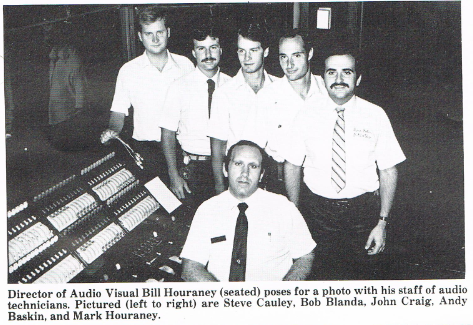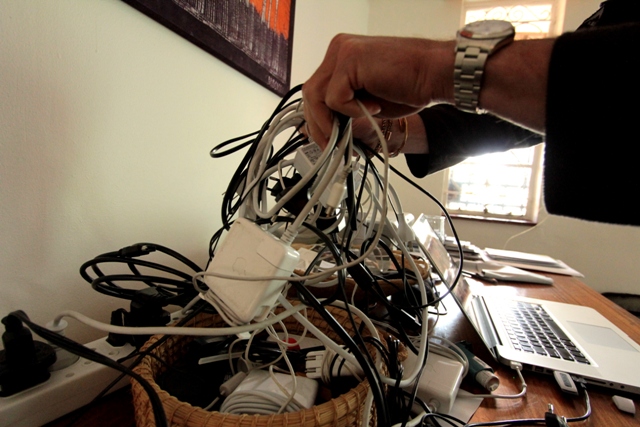– The Bottom Line –
Let's face it, we all are little nuts. And being 'The Bottom Line Guy' I have to confess I am included, if not 'a stand out' among all of the 'normal' nuts. Since I worked as a Director of Staging & Audio Visual back in the '80s, I have come to know and hate 'The Wire God.'
The Wire God is second only to the real God in his powers. No matter what religion you are or even if you have no God in your life, The Wire God is with you every day you are on this earth. His miracles are so defying to the laws of physics and common sense that every time he performs one, which is daily in most lives, I am awed!
The technicians daily battle against the mystifying powers of The Wire God
If you don't know what the hell I'm talking about, then next time you lay down 2 or more wires together for more than 30 seconds, you will witness the power of The Wire God. Since a picture is worth a thousand words, then just take a look at this and you will recognize something most have experienced but never realized; the magical powers of The Wire God.
And if you are still skeptical and want more evidence, then click HERE
Still think I'm a loon, then I have some real good loony friends over at no less than the PNAS:
About PNAS
Proceedings of the National Academy of Sciences of the United States of America
PNAS is one of the world's most-cited multidisciplinary scientific serials. Since its establishment in 1914, it continues to publish cutting-edge research reports, commentaries, reviews, perspectives, colloquium papers, and actions of the Academy. Coverage in PNAS spans the biological, physical, and social sciences. ?????? ???? ????????
And here's these loony scientists take on 'The Wire God':
Spontaneous knotting of an agitated string
by Dorian M. Raymer and Douglas E. Smith* – Edited by Leo P. Kadanoff, University of Chicago, Chicago, IL, and approved July 30, 2007 (received for review December 21, 2006)
Abstract
It is well known that a jostled string tends to become knotted; yet the factors governing the “spontaneous” formation of various knots are unclear. We performed experiments in which a string was tumbled inside a box and found that complex knots often form within seconds. We used mathematical knot theory to analyze the knots. Above a critical string length, the probability P of knotting at first increased sharply with length but then saturated below 100%. This behavior differs from that of mathematical self-avoiding random walks, where P has been proven to approach 100%. Finite agitation time and jamming of the string due to its stiffness result in lower probability, but P approaches 100% with long, flexible strings. We analyzed the knots by calculating their Jones polynomials via computer analysis of digital photos of the string. Remarkably, almost all were identified as prime knots: 120 different types, having minimum crossing numbers up to 11, were observed in 3,415 trials. All prime knots with up to seven crossings were observed. The relative probability of forming a knot decreased exponentially with minimum crossing number and Möbius energy, mathematical measures of knot complexity. Based on the observation that long, stiff strings tend to form a coiled structure when confined, we propose a simple model to describe the knot formation based on random “braid moves” of the string end. Our model can qualitatively account for the observed distribution of knots and dependence on agitation time and string length.
I just love these genius guys. They are so brainy and give us all of our modern day marvels that make our lives so easy and more enjoyable. BUT as Ben Cartwright (Bonanza) said to his son Adam:" I have nothing against an education as long as it doesn't interfere with your thinking…"
All this scientific stuff is great but and a valiant attempt to describe this phenomenon but it only serves to provide further proof of the existence and the powers of The Wire God.
Here's another 'loon' weighing in on The Wire God:
The Science of Tangled Cords
October 13, 2011 By
It is a common complaint and an often head-scratching mystery: “How the heck did these cords get so tangled together?” In 2007, student Dorian Raymer and physics professor Doug Smith at the University of California at San Diego conducted an experiment to solve the mystery of “”Spontaneous Knotting of an Agitated String“. Using a computer program and motorized boxes, strings of varying lengths were tumbled inside and it was found that complex knots often form within seconds. They repeated the test 3000 more times, using strings of different lengths and stiffness, and boxes of varying sizes, to determine whether there were any rules that could be applied to the knotting of a string. Overall, 120 different types of knots were counted. read more
BUT WAIT !!
'The Wire God' – His Days Are Numbered!
Just like cloning, this is something I gotta stick around to witness before I leave this stage
That's right my 'prayers' may be answered! More of the genius guys over at MIT may just have numbered the days left for The Wire God to rule over us. They have begun to eliminate the need for electrical wires which would make the powers of The Wire God useless! 'God bless the guys at MIT'
Editor's Note: This is not current news. The article is from 2007 (How I missed it I don't know – more powers of TWG? ??? ???? ?? ??????? ) It remains however so important and indeed lethal news for The Wire God…
MIT Makes Breakthrough in Wireless Electricity
Posted on August 3, 2007 by Karen M. Cheung
August 3, 2007 – Today’s consumers are plagued with having to remember to charge their cell phones, plug in their laptops, and, for photographers, recharge their camera batteries. But researchers at the Massachusetts Institute of Technology have made a breakthrough in what scientists call "WiTricity," or wireless electricity. MIT researchers last month announced they successfully lit a 60-watt light bulb from a power source two meters away without a wired connection, signaling that some day consumers may be able to power electronics without cords.
"Look behind your desk. There are a number of annoying wires," said MIT Ph. ???? ???? D. candidate Aristeidis Karalis in an interview with DigitalCameraInfo.com. "It would be great to get rid of them."
With hopes to cut out the use of power cords, MIT researchers used a specific kind of energy, electromagnetic radiation. When two objects vibrate at the same frequency, the pair makes for a strong couple that can effectively transfer energy. The researchers used two cooper coils as magnetically coupled resonators; one for sending out the non-radiative energy, and one to receive it (in this case, the light bulb).
Read Complete Article at Digital Camera Info.com















